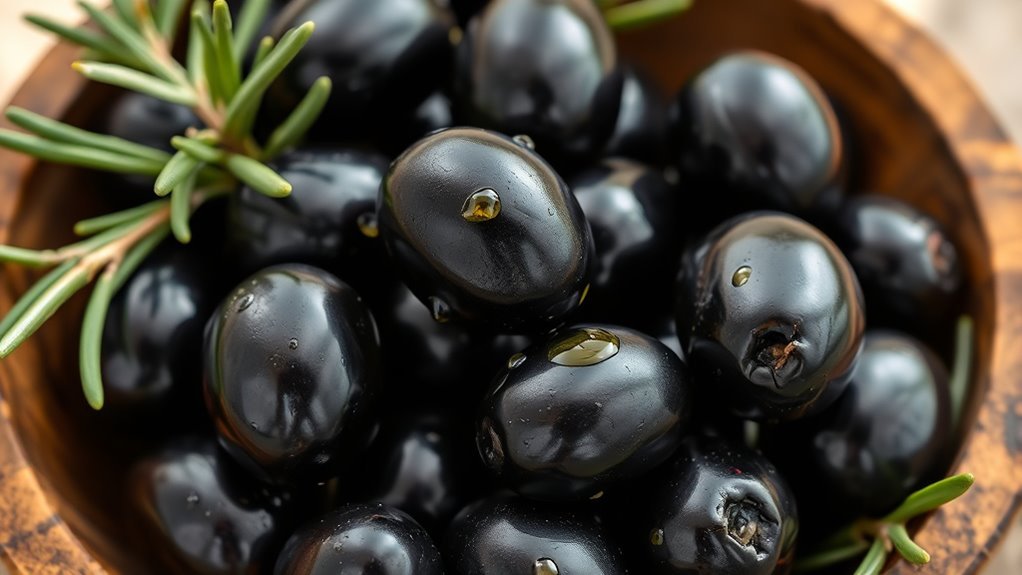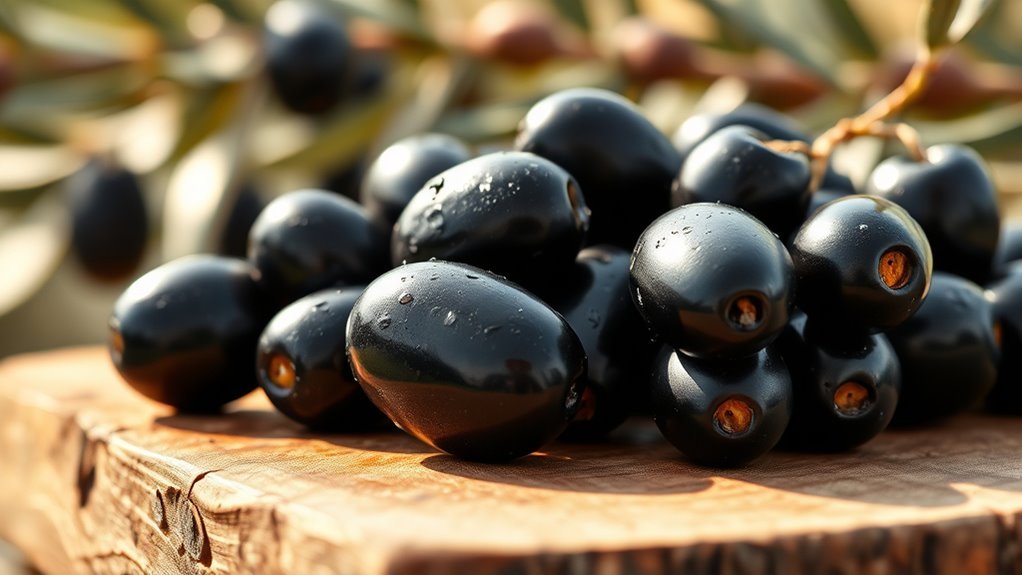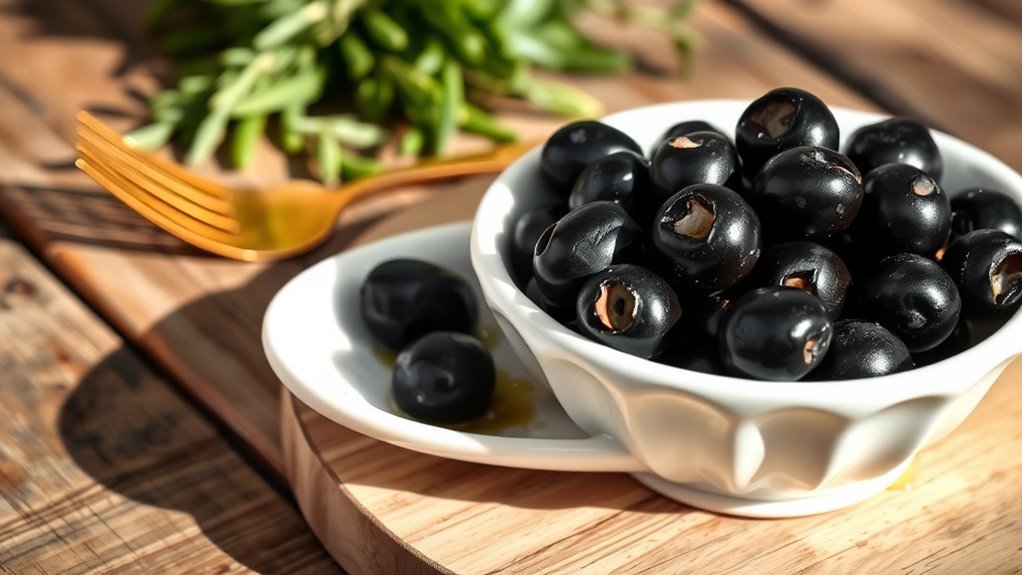Yes, black olives are keto-friendly! They contain about 6 grams of total carbohydrates per 100 grams, with only 3 grams as net carbs, thanks to their fiber content. Rich in healthy monounsaturated fats and antioxidants, they support heart health and provide essential minerals. However, be mindful of sodium levels. Typically, a serving is around 10 to 15 olives. If you want to discover more about how to incorporate black olives into your meals, keep on exploring!
Nutritional Profile of Black Olives

When considering a keto diet, it’s important to understand the nutritional profile of black olives. These small fruits pack a powerful punch of health benefits. Black olives are low in carbohydrates, making them ideal for your keto lifestyle. They’re rich in healthy fats, primarily monounsaturated fats, which can support heart health. Additionally, black olives contain antioxidants like vitamin E and polyphenols, offering anti-inflammatory properties. You’ll also find vital minerals such as iron and copper, which play significant roles in your body’s functions. Their high fiber content aids digestion, further enhancing their nutritional benefits. Including black olives in your meals can provide flavor and health advantages, making them a smart choice for anyone seeking freedom in their dietary choices.
Carb Count in Black Olives

Black olives are not just nutritious; they’re also low in carbohydrates, making them a perfect fit for a keto diet. In a standard serving of about 100 grams, you’ll find approximately 6 grams of total carbohydrates, with about 3 grams of fiber. This brings the net carb content down to around 3 grams, which is quite appealing for anyone monitoring their carb intake. When considering serving suggestions, you might enjoy them sliced in salads, blended into tapenade, or as a savory snack. Their rich flavor enhances a variety of dishes without adding significant carbs, allowing you to indulge in tasty options while staying aligned with your keto goals. Enjoy the freedom of choosing black olives for your meals!
Health Benefits of Black Olives

Though often overlooked, black olives offer a range of health benefits that can contribute to your overall wellness. Rich in healthy fats, they can support heart health by reducing inflammation and lowering cholesterol levels. Their high antioxidant properties help combat oxidative stress, which is crucial for maintaining cellular health. Additionally, black olives contain vitamins E and A, both of which are essential for skin health and immune function. You’ll also find iron and copper, important for energy production and red blood cell formation. Incorporating black olives into your diet can not only enhance your meals but also provide these essential nutrients, making them a smart addition to a balanced lifestyle.
How Black Olives Fit Into a Keto Diet
Incorporating black olives into your keto diet can be a delicious and nutritious choice. These small fruits are low in carbohydrates, making them ideal for maintaining ketosis. They’re rich in healthy fats, particularly monounsaturated fats, which can support heart health. The health benefits of black olives also include antioxidants that may help combat inflammation and oxidative stress.
When it comes to serving suggestions, consider adding black olives to salads, antipasto platters, or as a savory snack. You can even blend them into tapenade for a flavorful spread. With their robust taste and versatility, black olives not only enhance your meals but also contribute to your overall keto-friendly lifestyle. Enjoy their rich flavor while reaping their numerous benefits!
Portion Control and Serving Sizes
When you’re enjoying black olives on a keto diet, portion control is essential to keep your carbohydrate intake in check. Black olives are low in carbs, but it’s easy to overindulge. A typical serving size is about 10 to 15 olives, which contains roughly 2 to 3 grams of net carbs. To maintain balance, consider measuring out portion sizes rather than eating directly from the jar. You might use a small bowl for serving suggestions, making it easier to enjoy them without losing track. Incorporating black olives into salads or as a topping can also help you manage your intake while retaining flavor. Remember, moderation is key to staying within your keto guidelines and enjoying the freedom of your diet.
Ways to Incorporate Black Olives in Meals
Finding delicious ways to incorporate black olives into your meals can elevate your keto diet while keeping your carb count low. One tasty option is to whip up a black olive tapenade. Just blend black olives with garlic, capers, and olive oil for a flavorful spread that pairs well with low-carb veggies or keto crackers. You can also enjoy stuffed black olives, which are perfect for snacking or adding to salads. Fill them with cream cheese, feta, or herbs for a delightful bite. Additionally, tossing black olives into your favorite Mediterranean dishes, like chicken or fish, enhances flavor and nutrition without excess carbs. Making these simple adjustments will keep your meals vibrant and satisfying while staying true to your keto goals.
Comparing Black Olives to Other Olives
When comparing black olives to other types like green or Kalamata olives, you’ll notice distinct differences in their nutritional profiles, including varying levels of fats and antioxidants. Additionally, the flavor and texture can greatly impact your culinary choices, with black olives offering a milder taste and a softer bite. Understanding these variations can help you make informed decisions based on your dietary preferences and recipe needs.
Nutritional Profile Differences
Although black olives are often praised for their rich flavor and versatility, their nutritional profile can differ considerably from that of green olives and other varieties. Black olives typically contain slightly more calories and fats, primarily healthy monounsaturated fats, making them a great choice for those following a keto diet. In contrast, green olives tend to be lower in calories and carbs, appealing to different taste preferences and culinary uses. Both types are rich in antioxidants and provide essential nutrients, but their sodium content can vary considerably depending on how they’re processed. Understanding these differences can help you make informed choices that align with your dietary goals while enjoying the diverse flavors olives offer.
Flavor and Texture Variations
While many people enjoy olives for their unique taste, the flavor and texture of black olives can differ markedly from their green counterparts and other varieties. Black olives typically have a richer, more robust taste profile, often described as slightly sweet and buttery. In contrast, green olives tend to be more bitter and tangy, providing a sharp, briny flavor. When it comes to texture variations, black olives are generally softer and less fibrous than green olives, which can be firmer and crunchier. This difference in texture can influence your culinary choices, depending on whether you’re adding them to salads, pizzas, or tapenades. Understanding these variations helps you appreciate the distinct qualities of each olive type and enhance your dishes accordingly.
Potential Drawbacks of Eating Black Olives
While black olives can be a tasty addition to your diet, you should be aware of their high sodium content, which may impact your blood pressure. Additionally, their caloric density means that eating them in moderation is essential, especially if you’re tracking your overall calorie intake. Understanding these potential drawbacks can help you make informed dietary choices.
High Sodium Content
When contemplating the inclusion of black olives in a keto diet, it’s important to be mindful of their high sodium content. While they can be a tasty addition, excessive sodium can lead to several sodium concerns, especially if you’re watching your intake. Here are a few hydration effects to ponder:
- Increased Thirst: High sodium levels can make you feel more dehydrated, prompting you to drink more water.
- Blood Pressure Fluctuations: If you’re sensitive to sodium, it might affect your blood pressure, which could be risky for some individuals.
- Kidney Strain: Excess sodium can put added stress on your kidneys, particularly if you consume them frequently.
Keeping these factors in mind can help you enjoy black olives without compromising your health.
Caloric Density Consideration
High sodium content isn’t the only factor to contemplate when evaluating black olives for a keto diet. Their caloric density is another significant consideration. Black olives pack about 115 calories per 100 grams, which can add up quickly if you’re not mindful. While they provide healthy fats, these calories can impact your daily intake, especially if you’re aiming for a specific macronutrient balance. When serving suggestions arise, it’s wise to measure portions carefully—consider a small handful or incorporate them into salads or dishes for added flavor without excessive calories. Balancing black olives with other low-calorie, high-fiber foods can help maintain your keto goals while enjoying their unique taste. Be aware of how they fit into your overall dietary framework.
Recipes Featuring Black Olives for Keto Dieters
If you’re looking to enhance your keto diet with flavorful, low-carb ingredients, black olives can be a delicious addition. Their rich taste complements various dishes while keeping your carb count low. Here are three easy recipes to try:
- Black Olive Tapenade: Blend black olives, olive oil, garlic, and herbs for a savory spread that’s perfect on keto crackers or veggies.
- Stuffed Black Olives: Fill black olives with cream cheese or goat cheese, adding spices for extra flavor—a perfect snack or appetizer.
- Mediterranean Salad: Toss black olives with cucumbers, cherry tomatoes, feta, and a drizzle of olive oil for a revitalizing side dish.
Incorporating these recipes into your meal plan can make your keto journey both enjoyable and satisfying!


